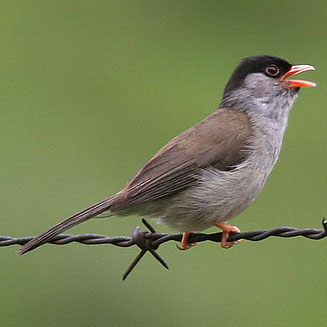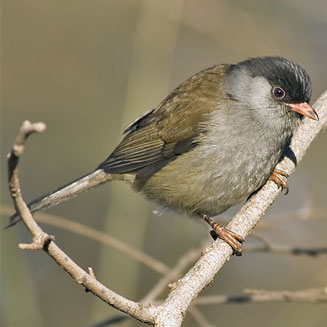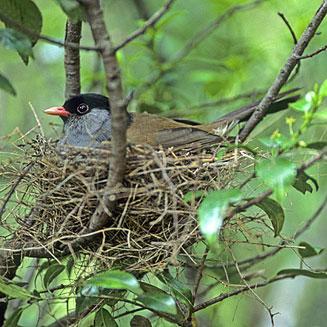|
Lioptilus nigricapillus (Bush
blackcap)
Rooibektiptol [Afrikaans]; Kaapse zwartkaptimalia [Dutch];
Lioptile ŗ calotte noire [French]; Buschschwarzkšppchen [German];
Barrete-preto-do-mato [Portuguese]
Life
> Eukaryotes >
Opisthokonta
> Metazoa (animals) >
Bilateria >
Deuterostomia > Chordata >
Craniata > Vertebrata (vertebrates) > Gnathostomata (jawed
vertebrates) > Teleostomi (teleost fish) > Osteichthyes (bony fish) > Class:
Sarcopterygii (lobe-finned
fish) > Stegocephalia (terrestrial
vertebrates) > Tetrapoda
(four-legged vertebrates) > Reptiliomorpha > Amniota >
Reptilia (reptiles) >
Romeriida > Diapsida > Archosauromorpha > Archosauria >
Dinosauria
(dinosaurs) > Saurischia > Theropoda (bipedal predatory dinosaurs) >
Coelurosauria > Maniraptora > Aves
(birds) > Order: Passeriformes
> Family: Sylviidae
 |
 |
|
Bush blackcap, Sani Pass, South Africa. [photo
Trevor Hardaker ©] |
Bush blackcap juvenile, Heidelberg, Gauteng, South
Africa (about 200 km from its normal distribution range. [photo
Johann du Preez
©] |
Distribution and habitat
Endemic to South Africa and western Swaziland, it is
uncommon to locally common in Afromontane forest patches, especially if fringed
by scrubby hillsides or thickets. In winter it sometimes moves into coastal
forest and valley bushveld.
|
 |
|
Distribution of Bush blackcap in southern Africa,
based on statistical smoothing of the records from first SA Bird Atlas
Project (©
Animal Demography unit, University of
Cape Town; smoothing by Birgit Erni and Francesca Little). Colours range
from dark blue (most common) through to yellow (least common).
See here for the latest distribution
from the SABAP2. |
Food
Its diet is not well known, however it is thought to mainly
eat fruit, supplemented with insects gleaned from vegetation.
Breeding
- The nest is built by both sexes, consisting of a neat cup of forbs, grass,
leaf petioles, twigs and rootlets. It is typically placed in a fork in the
upper branches of a tree or shrub, often near watercourses.
 |
|
|
Bush blackcap at its nest, Wakkerstroom, South
Africa. [photo Warwick Tarboton ©] |
|
- Egg-laying season is from November-January.
- It lays about 2 eggs, usually coloured dull white with streaked brown
markings.
- Both adults care for the chicks, however they are strangely tame and
unperturbed by any intruders near the nest, not even bothering to perform
distraction displays.
Threats
Not threatened, as much of its preferred habitat is in
protected areas.
References
-
Hockey PAR, Dean WRJ and Ryan PG 2005. Roberts
- Birds of southern Africa, VIIth ed. The Trustees of the John Voelcker
Bird Book Fund, Cape Town.
|
